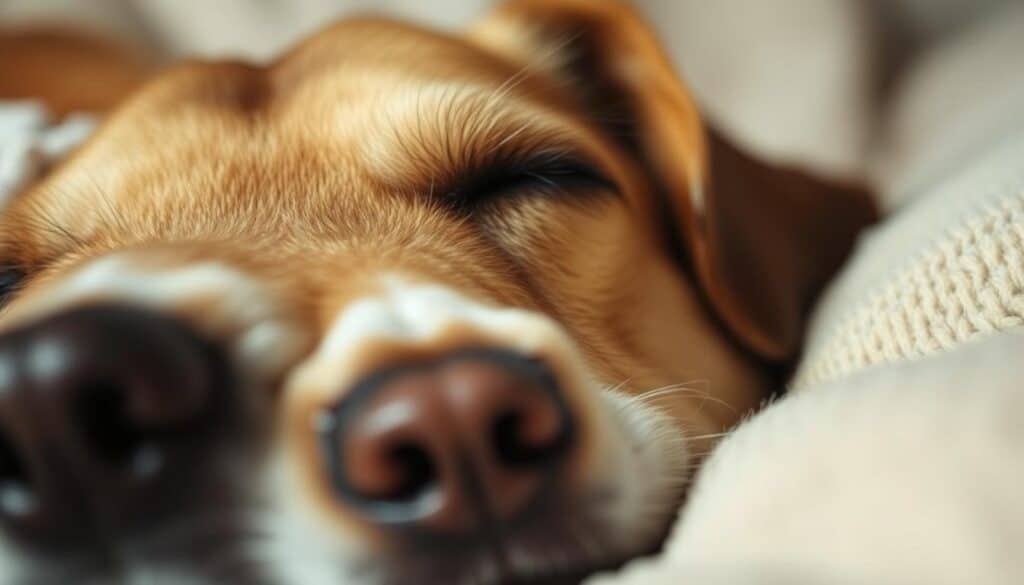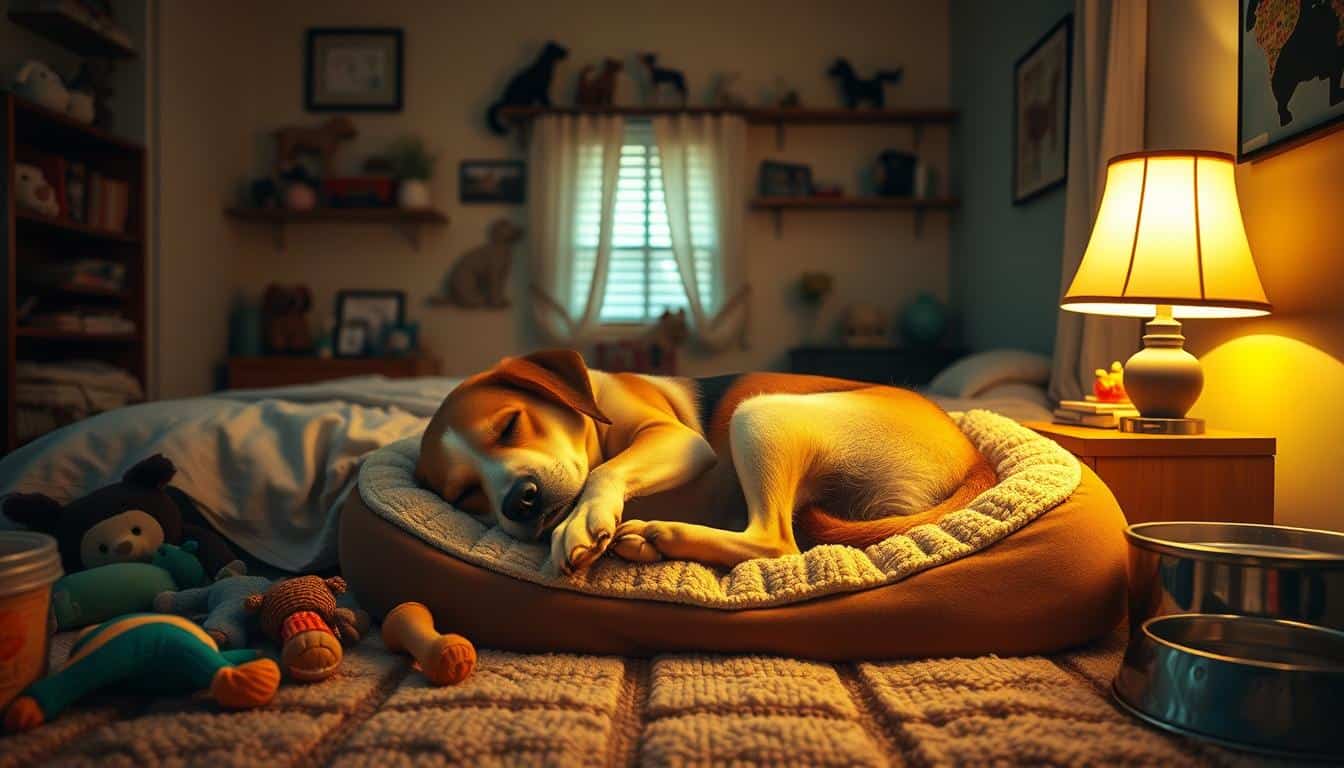Dogs balance bursts of energy with plenty of rest. While they love playtime and walks, they also spend a significant portion of their day snoozing. Understanding their sleep habits helps pet owners ensure their furry friends stay healthy.
On average, canines rest between 12 to 14 hours daily, though this varies. Puppies and senior dogs often need more downtime, while active breeds may sleep less. Lifestyle and health also play a role in their rest patterns.
Veterinarians like Dr. Jonathan Roberts and Dr. Brian Evans emphasize monitoring sleep for overall well-being. Factors such as age, breed, and activity level influence how much shut-eye they require. Recognizing these differences helps tailor care for each pet.
From playful pups to laid-back seniors, sleep needs evolve. By observing habits, owners can spot potential health concerns early. A well-rested dog is a happy, energetic companion.
How Many Hours a Day Does a Dog Sleep? The Basics

From playful pups to aging companions, rest needs vary significantly. Age, breed, and health shape these patterns, making each dog’s schedule unique.
Average Sleep Duration for Adult Dogs
Adult dogs split their rest between nighttime sleep and daytime naps. They typically sleep 6–8 hours overnight, supplemented by 10–18 hours of light dozing. This segmented approach helps them recharge between activities.
Active breeds like Border Collies may sleep less, while Bulldogs often lounge longer. *Dr. Sarah Lin*, a veterinary sleep specialist, notes: “Consistency in rest supports metabolism and behavior.”
Puppies vs. Senior Dogs: Key Differences
Puppies spend up to 20 hours per day sleeping during growth spurts. Their rest fuels brain development and muscle growth. Short bursts of play alternate with deep, restorative naps.
Senior dogs often nap more due to joint stiffness or sensory decline. Older pets prioritize comfort, seeking soft beds and quiet spaces. Monitoring changes helps detect issues like arthritis early.
Why Dogs Need More Sleep Than Humans

Unlike humans, dogs have unique sleep patterns tailored to their biological needs. Their shorter REM cycles and higher energy expenditure demand longer rest periods for optimal health.
The Role of REM Sleep in Dogs
Dogs spend only 10% of their sleep in REM, compared to 25% in humans. This phase is crucial for memory consolidation and emotional processing. *Dr. Lisa Freeman*, a veterinary neurologist, explains: “REM helps dogs retain training cues and adapt to new environments.”
Light sleepers by nature, canines wake easily due to irregular sleep-wake cycles. Breeds like Border Collies rely on these brief, intense rest phases to recover from high-energy tasks.
Energy Expenditure and Recovery
Active dogs burn calories rapidly, requiring sleep to rebuild muscles and strengthen immunity. Key metabolic benefits include:
- Repairing tissue damage after exercise.
- Regulating hormones that control appetite and stress.
- Boosting cognitive function for problem-solving breeds.
Working dogs, such as German Shepherds, often nap intensely post-activity. Their sleep patterns reflect a balance between exertion and recovery—far more fragmented than human cycles.
Factors Influencing Your Dog’s Sleep Patterns
Breed, activity level, and surroundings shape canine rest patterns uniquely. While some dogs thrive on short naps, others need extended downtime to recharge. Understanding these factors helps owners tailor care for optimal health.
Breed-Specific Sleep Tendencies
Large breeds like Mastiffs or Great Danes may sleep up to 18 hours daily. Their size demands more energy for basic functions. Smaller dogs, such as Chihuahuas, often rest 14–16 hours but wake more frequently.
Historically, working dogs like Huskies evolved with shorter sleep cycles for endurance. In contrast, Bulldogs prioritize lounging—a trait tied to their low-energy lineage.
Activity and Mental Stimulation
Regular exercise balances energy levels, preventing restless nights. Dr. Ellen Choi, a canine behaviorist, notes: “Bored dogs may oversleep or chew furniture out of frustration.” Puzzle toys or training sessions combat boredom effectively.
Environmental Stressors
Noisy surroundings—like fireworks or construction—disrupt deep sleep. Household changes (new pets, moving) also trigger anxiety. Solutions include:
- White noise machines for sound sensitivity.
- Structured bedtime routines for predictability.
- Calming supplements (vet-approved) for transitions.
Monitoring these health influences ensures restful, restorative sleep for every pup.
Health and Sleep: When to Be Concerned
Sudden changes in sleep patterns often signal underlying medical issues. While rest is essential, excessive drowsiness or restlessness can indicate health problems. Owners should observe shifts in behavior, especially in older dogs.
Recognizing Excessive Sleep
Lethargy, withdrawal from play, or prolonged napping may suggest trouble. Common red flags include:
- Sudden increase in sleep duration.
- Disinterest in meals or favorite activities.
- Hiding or avoiding interaction.
*Dr. Emily Torres*, a veterinary internist, notes: “Isolation paired with excessive sleep often points to pain or metabolic issues.”
Potential Underlying Conditions
Hypothyroidism, arthritis, or heart disease can disrupt rest. Diagnostic steps include:
- Thyroid panels to rule out hormonal imbalances.
- Urinalysis for diabetes screening.
- Physical exams to detect joint pain.
For example, Mabel the Chihuahua’s sudden lethargy led to a diabetes diagnosis. Early vet visits are crucial for timely intervention.
Breed Spotlight: Which Dogs Sleep the Most?
Sleep habits vary dramatically across different dog breeds. Genetics, size, and historical roles shape their rest needs. Some nap frequently, while others recharge in short bursts.
Large Breeds: Masters of Relaxation
Mastiffs and Great Danes sleep up to 18 hours daily. Their massive size demands energy conservation. Dr. Georgina Ushi Phillips notes: “Giant breeds prioritize rest to support joint health and metabolism.”
Greyhounds balance sprinting with prolonged downtime. Despite their athleticism, they sleep deeply to recover. Key contrasts include:
- Mastiffs: Low-energy, preferring couch lounging.
- Greyhounds: Burst activity followed by 16-hour rest cycles.
Companion Breeds: Built for Comfort
Shih Tzus and Bulldogs thrive on 14–16 hours of rest. Brachycephalic (short-nosed) breeds like Bulldogs pause frequently due to breathing challenges. Their naps are shorter but more frequent.
Lapdogs like Pekingese adapt to owner schedules, while Retrievers stay alert for tasks. Dr. Phillips adds: “Companion breeds often sync their sleep with human routines.”
Creating an Ideal Sleep Environment for Your Dog
Quality rest starts with a well-designed sleep setup. Dogs, like humans, benefit from a dedicated space that supports their rest patterns. From orthopedic beds to mindful exercise routines, small changes can make a big difference.
Choosing the Right Bed for Support
A dog bed should match your pet’s needs. Senior dogs with arthritis often thrive on memory foam for joint relief. Thick-coated breeds, like Huskies, may prefer cooling mats to regulate temperature.
Puppies adapt well to crate training, which establishes secure sleep routines. Dr. Rachel Kim, a veterinary orthopedist, notes: “Proper support prevents long-term mobility issues.”
Balancing Exercise and Rest
Daytime activity directly impacts nighttime rest. A brisk evening walk or “sniffari” (scent-focused stroll) tires dogs mentally and physically. Avoid late-night meals to prevent disruptive bathroom trips.
Key tips for harmony:
- Schedule exercise 2–3 hours before bedtime.
- Rotate puzzle toys to curb boredom.
- Monitor energy levels to adjust routines.
Consistency helps dogs unwind, leading to deeper, more restorative sleep.
Helping Your Dog Rest Better
Creating a restful routine helps dogs recharge and stay healthy. Fixed feeding and walking times regulate their internal clock, reducing anxiety. A pre-bedtime bathroom break minimizes nighttime disruptions.
For pets with separation stress, calming tools like Thundershirts or white noise machines ease tension. In severe cases, vet-approved supplements (melatonin or CBD) may promote relaxation.
Success stories show adaptability—like Max, a Labrador who thrived after his family moved. A consistent schedule helped him adjust within weeks.
Quick checklist for better rest:
- Set consistent meal and walk times.
- Provide a quiet, comfortable sleeping space.
- Monitor changes in patterns and consult a vet if needed.





